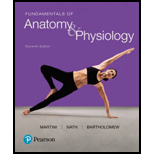
Fundamentals of Anatomy & Physiology (11th Edition)
11th Edition
ISBN: 9780134396026
Author: Frederic H. Martini, Judi L. Nath, Edwin F. Bartholomew
Publisher: PEARSON
expand_more
expand_more
format_list_bulleted
Concept explainers
Question
Chapter 11, Problem 25RQ
Summary Introduction
To determine:
The reason that the convergent muscle exhibit more versatility when contracting than does a parallel muscle.
Introduction:
According to the organization of fascicles, the skeletal muscles are classified into four groups. The four groups are parallel muscles, convergent muscles, the pennate muscles and the circular muscles.
Expert Solution & Answer
Want to see the full answer?
Check out a sample textbook solution
Students have asked these similar questions
Explain the role of agonist, antagonist, synergist, and fixator muscles. Give two examples of each.
Why is it incorrect to talk about ‘flexing a muscle’?
In a resting (non-contracting) muscle, what is the position of myosin?
It is attached to the tropomyosin.
It is in the high-energy, cocked position.
It is attached to the actin.
It is in the low-energy, bent position.
Chapter 11 Solutions
Fundamentals of Anatomy & Physiology (11th Edition)
Ch. 11 - Based on patterns of fascicle arrangement, name...Ch. 11 - Why does a pennate muscle generate more tension...Ch. 11 - Prob. 3CPCh. 11 - Define a lever, and describe the three classes of...Ch. 11 - The joint between the occipital bone of the skull...Ch. 11 - Prob. 6CPCh. 11 - Muscle A abducts the humerus, and muscle B adducts...Ch. 11 - Prob. 8CPCh. 11 - Prob. 9CPCh. 11 - Prob. 10CP
Ch. 11 - Describe the location and general functions of...Ch. 11 - Describe the location and general functions of...Ch. 11 - Prob. 13CPCh. 11 - Prob. 14CPCh. 11 - Prob. 15CPCh. 11 - Damage to the external intercostal muscles would...Ch. 11 - If someone hit you in your rectus abdominis, how...Ch. 11 - Prob. 18CPCh. 11 - Prob. 19CPCh. 11 - Prob. 20CPCh. 11 - Prob. 21CPCh. 11 - Prob. 22CPCh. 11 - Prob. 23CPCh. 11 - How would a torn calcaneal tendon affect movement...Ch. 11 - What major function does the muscular system...Ch. 11 - Identify the physiological effects of exercise on...Ch. 11 - Prob. 1RQCh. 11 - Prob. 2RQCh. 11 - Prob. 3RQCh. 11 - Prob. 4RQCh. 11 - Prob. 5RQCh. 11 - Prob. 6RQCh. 11 - The strongest masticatory muscle is the (a)...Ch. 11 - Prob. 8RQCh. 11 - Prob. 9RQCh. 11 - The major extensor of the elbow is the (a) triceps...Ch. 11 - Prob. 11RQCh. 11 - Prob. 12RQCh. 11 - Prob. 13RQCh. 11 - Prob. 14RQCh. 11 - What is an aponeurosis? Give two examples.Ch. 11 - Prob. 16RQCh. 11 - Prob. 17RQCh. 11 - On which bones do the four rotator cuff muscles...Ch. 11 - Prob. 19RQCh. 11 - Prob. 20RQCh. 11 - Compartment syndrome can result from all of the...Ch. 11 - Prob. 22RQCh. 11 - Prob. 23RQCh. 11 - Prob. 24RQCh. 11 - Prob. 25RQCh. 11 - Prob. 26RQCh. 11 - Prob. 27RQCh. 11 - Prob. 28RQCh. 11 - Prob. 29RQCh. 11 - Prob. 30RQCh. 11 - Prob. 31RQCh. 11 - Prob. 1CCCh. 11 - Prob. 2CC
Knowledge Booster
Learn more about
Need a deep-dive on the concept behind this application? Look no further. Learn more about this topic, biology and related others by exploring similar questions and additional content below.Similar questions
- In a general sense, how do skeletal muscles produce movement?arrow_forwardIf a muscle is contracted and shortening, what happens to the following: (a) width of the A band, (b) width of the H zone, (c) relationship of the Z discs, and (d) width of the I band?arrow_forwardWhat are the difference between red and white muscle?arrow_forward
- which arrangement best describes bipennate muscle?arrow_forwardYou are competing in a pull-up competition. What type of muscle contractions are occurring in your latissimus dorsi muscles immediately after you grab the bar? As your body begins to move upward toward the bar? When your body begins to approach the mat?arrow_forwardWhy might stretching a cramping muscle INCREASE the cramping, as well as why would contracting the opposing muscle rapidly improve the situation?arrow_forward
- What are the chronological steps of a muscle contracting? From the start at the neuromuscular junction up until the sarcomere shortening?arrow_forwardWhy can smooth muscles contract over a wider range of resting lengths than skeletal and cardiac muscle?arrow_forwardWhat type of muscle contraction is required at the hip during the action of moving from standing to sitting down in a chair? isometric, eccentric or concentric? What muscles are producing the force at the hip during this movement?arrow_forward
- Sketch the fascicle arrangements that define a fusiform, parallel, convergent, pennate, and circular muscle?arrow_forwardExplain, structurally, why pennate muscles tend to be very powerful. What aspect of muscular function do they typically sacrifice to achieve this power of contraction?arrow_forwardSKELETAL MUSCLES OF CATS Describe the following terms: Fascia – superficial and deep Aponeuroses Tendon Platysma Muscle Origin Muscle Insertionarrow_forward
arrow_back_ios
SEE MORE QUESTIONS
arrow_forward_ios
Recommended textbooks for you
 Human Biology (MindTap Course List)BiologyISBN:9781305112100Author:Cecie Starr, Beverly McMillanPublisher:Cengage Learning
Human Biology (MindTap Course List)BiologyISBN:9781305112100Author:Cecie Starr, Beverly McMillanPublisher:Cengage Learning Human Physiology: From Cells to Systems (MindTap ...BiologyISBN:9781285866932Author:Lauralee SherwoodPublisher:Cengage Learning
Human Physiology: From Cells to Systems (MindTap ...BiologyISBN:9781285866932Author:Lauralee SherwoodPublisher:Cengage Learning

Human Biology (MindTap Course List)
Biology
ISBN:9781305112100
Author:Cecie Starr, Beverly McMillan
Publisher:Cengage Learning

Human Physiology: From Cells to Systems (MindTap ...
Biology
ISBN:9781285866932
Author:Lauralee Sherwood
Publisher:Cengage Learning
GCSE PE - ANTAGONISTIC MUSCLE ACTION - Anatomy and Physiology (Skeletal and Muscular System - 1.5); Author: igpe_complete;https://www.youtube.com/watch?v=6hm_9jQRoO4;License: Standard Youtube License